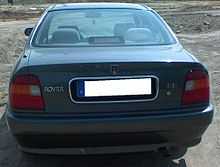Rover 600 Series
| Rover 600 Series | |
|---|---|
 | |
| Overview | |
| Manufacturer | Rover |
| Production | 1993—1999 |
| Designer | Richard Woolley (1989) |
| Body and chassis | |
| Class | Compact executive car |
| Body style | 4-door saloon |
| Layout | FF layout |
| Related | Honda Accord |
| Powertrain | |
| Engine |
1.8 L I4 2.0 L I4 2.3 L I4 2.0 L Diesel I4 2.0 Turbo (petrol) |
| Chronology | |
| Predecessor | Austin Montego |
| Successor | Rover 75 |
The Rover 600 Series is a compact executive car range produced under the British marque Rover from 1993 to 1999.
The Rover 600 exterior was designed by Rover, a re-skin of the European Honda Accord, also built in the UK by Honda in Swindon. The core structure and vast majority of the engineering content was sourced from Honda but the vehicles were designed at the same time, with a small Rover team on-site in Japan. Colour and trim derivatives were also used to help separate the Rover from the Honda in the marketplace. The 1.8, 2.0 and 2.3-litre straight-4 petrol engines were all provided by Honda. However, the 2.0-litre turbodiesel Rover L-Series engine and turbocharged petrol engines were developed by Rover itself, evolutions of units already available elsewhere in the Rover model range.
The 600's interior included wood and chrome trim, as well as relatively high equipment levels, although rear legroom was criticised as rather constrained.[1] The interior was similar to the Japanese-built Honda Ascot Innova, except with a few cosmetic changes. Carpet was also not evident along the bottom trim of the dashboard, although it did feature there on the Innova.
The Honda-derived chassis was reported to give a comfortable but unsporting ride. Given the Rover's equipment, prices were reasonably competitive in the large family car segment and considerably lower than the price of such compact executive cars such as the BMW 3 Series and Audi A4.
After six years, Rover 600 production ceased in the Spring of 1999; it was replaced with the retro-styled Rover 75 developed under BMW's stewardship. The 75 also replaced the larger 800 Series.
The 600 had been a popular car in the compact executive sector, with a large percentage of sales being to the fleet market.[citation needed]
Versions
The 600 was available in the following versions:
- 618i
- 618 Si
- 620i
- 620 Si
- 620 SLi
- 620 GSi
- 623 SLi
- 623 GSi
- 623 iS
- 620ti
- 620 Di
- 620 SDi
- 620 SLDi
- 620 GSDi
Badging was determined by engine size: 618 models had 1.8-litre engines, 620 had 2.0 engines, 623 had 2.3-litre engines. With the exception of the T-Series 620ti, all petrol engines were sourced from Honda, and all diesel versions were L-Series units. The K-Series engine was not used in the 600.

The 600 was available in a number of different trims. All models had power-assisted steering (PAS), electric front windows, remote central locking with alarm and immobiliser and tinted windows. The Si had split rear seats, Si Auto and above got a sunroof. SLi trim added electric rear windows and wooden door trim; GSi models received 15" multispoke alloys and full leather trim. From 1994 all cars had a driver's airbag. The 623iS had half leather trim and a small lip spoiler on its boot. The ti featured a set of 16" six spoke alloys with uprated suspension, 'Torsen' gearbox and a dark half leather interior.
Run out models included:
- 618iL
- 618iS
- 620iSD
- 620iLD
S and SD models had the appearance of the 620ti, with the same six spoke 16" alloy wheels and half leather trim. L and LD models had seven spoke 15" alloy wheels and full leather trim resembling the GSi models.

The range was facelifted twice. The first revisions were in 1996 which included a slightly revised interior with a padded front arm rest and separate rear head rests, all models, apart from the ti, had 15" wheels, high level brake light, new alarm and immobiliser system (the alarm changed from an infra-red to a radio controlled handset and the ignition key became a 'transponder key', without which the immobiliser could not be disarmed), drink holders in the front doors, electric headlight adjuster and all models from Si specification upwards receive air-con and 15" alloys. At this time the T series changed ignition system from Distributor to 'wasted spark', pistons, Klinger head gasket, LSD and the steering was changed to Rover's Positive Centre Feel (PCF) system. UK cars which featured these revisions were all badged as "600" only, in line with most other models in the Rover range which no longer had badging by engine sizes.
The final revisions came in 1997, just over a year later, and all cars got slightly lowered suspension (~10 mm) and body-coloured sills, rubbing strips, door handles and door mirror covers.
References
- ↑ "Rover 600 (93-00)*". parkers.co.uk. Retrieved 2009-02-09.
External links
- Adams, Keith. "The Unofficial Austin Rover Web Resource".
| Wikimedia Commons has media related to Rover 600. |
| ||||||||
| |||||||||||||||||||||||||||||